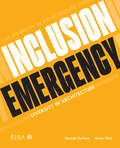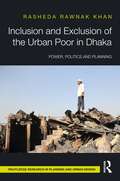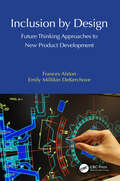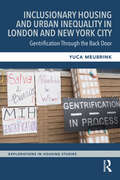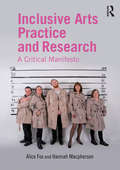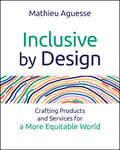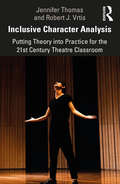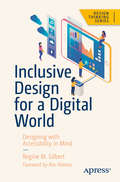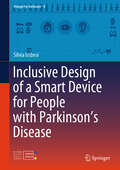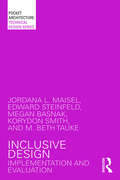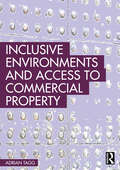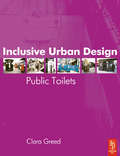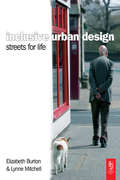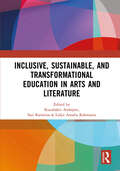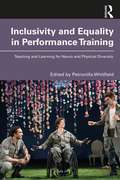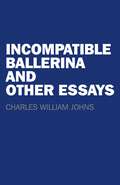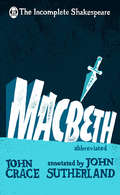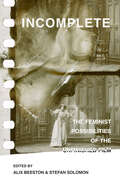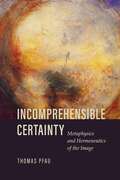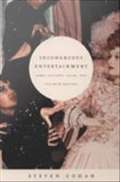- Table View
- List View
Inclusion Emergency: Diversity in architecture
by Hannah Durham Grace ChoiArchitecture is at a tipping point. Voices of the under-represented have been increasing in volume and are agitated for change. If we don’t collectively listen, re-adjust and change our future outlook, we limit the potential relevance of the profession in today’s society and, ultimately, the places we create. Capturing insight from leading voices in the profession, this book encourages understanding, reflection and addresses critical questions, providing steps towards meaningful change. It will help those who are under-represented to find role models, context and tools & to be confident, supported and valued. Building understanding for those more privileged to acknowledge bias, it will enable mitigation and awareness of the issues to encourage meaningful action. This is a call for change. Now.
Inclusion and Exclusion of the Urban Poor in Dhaka: Power, Politics, and Planning
by Rasheda Rawnak KhanInclusion and Exclusion of the Urban Poor in Dhaka explores how the inhabitants of poor neighborhoods in Dhaka, Bangladesh, gain inclusion in the city at the face of exclusion. The book considers how the people of poor neighborhoods encounter the exclusionary behavior of city development, and how their inclusionary attempts have influenced the urban design. The book is presented in two parts: first, it explains how people in poor neighborhoods face exclusion because of the imbalance of power and politics. Second, it demonstrates how the existing exclusion of urban poor is affecting their strategies to gain access to urban services through people’s power and politics. Focusing on the transdisciplinary field of urban anthropology, the chapters uncover the urban forces, policies and actions that facilitate urban politics. It also investigates the people who live in poor neighborhoods, who in the face of exclusion, have included themselves in urban development planning and design by employing diverse strategies against those forces in the urban politics, e.g., accepting dominance, bargaining, or having control over their lives. This book will recontextualize an ethnographic inquiry into the exclusion and inclusion of the people within city development design, plans and innovations in applications of anthropological theory and methodology. This book will encourage the reader to understand the politics of state’s development projects and plans, and furthermore instigate the city government, planners and policymakers to focus on the people's political power and agency that enables them to achieve inclusion. It will therefore be of interest to researchers and students of urban planning and development, urban geography, and urban anthropology, as well as planning professionals and policymakers.
Inclusion by Design: Future Thinking Approaches to New Product Development
by Frances Alston Emily Millikin DeKerchoveThis book introduces a new speculative design process for inclusive new product development (NPD). The authors offer Vision Enabled Design Thinking (VEDT), a human-centered technological design framework incorporating the use of Design Lens and Vision Concepting, as a way for the designer to ideate and reflect on product development concepts within a deeper sociocultural context. The authors incorporate project management concepts into the overall design process through the development of a new design process, "4-D Algorithm for New Product Development".Inclusion by Design: Future Thinking Approaches to New Product Development formalizes the use of speculative design as a means for more inclusive NPD and promotes management of the design process as a needed skill for future engineers and designers. It provides a novel design methodology of VEDT for engaging vision concepting, through the use of Design Lenses in engaging speculative design practices and offers an implementation framework to support the sustainable adoption and use of future design methods. The 4-D Algorithm for New Product Development promotes inclusivity in design while addressing practical aspects of managing the design process in today’s corporate business environment.Those involved with interactive product and technology design, new product development, design researchers and managers, engineers, as well as professionals and graduate students will find this book useful.
Inclusionary Housing and Urban Inequality in London and New York City: Gentrification Through the Back Door (ISSN)
by Yuca MeubrinkMunicipalities around the world have increasingly used inclusionary housing programs to address their housing shortages. This book problematizes those programs in London and New York City by offering an empirical, research-based perspective on the socio-spatial dimensions of inclusionary housing approaches in both cities. The aim of those programs is to produce affordable housing and foster greater socio-economic inclusion by mandating or incentivizing private developers to include affordable housing units within their market-rate residential developments.The starting point of this book is the so-called “poor door” practice in London and New York City, which results in mixed-income developments with separate entrances for “affordable housing” and wealthier market-rate residents. Focusing on this “poor door” practice allowed for a critical look at the housing program behind it. By exploring the relationship between inclusionary housing, new-build gentrification, and austerity urbanism, this book highlights the complexity of the planning process and the ambivalences and interdependencies of the actors involved. Thereby, it provides evidence that the provision of affordable housing or social mixing through this program has only limited success and, above all, that it promotes – in a sense through the “back door” – the very gentrification and displacement mechanisms it is supposed to counteract.This book will be of interest to researchers and students of housing studies, planning, and urban sociology, as well as planners and policymakers who are interested in the consequences of their own housing programs.
Inclusive Arts Practice and Research: A Critical Manifesto
by Alice Fox Hannah MacphersonInclusive Arts Practice and Research interrogates an exciting and newly emergent field: the creative collaborations between learning-disabled and non-learning-disabled artists which are increasingly taking place in performance and the visual arts. In Inclusive Arts Practice Alice Fox and Hannah Macpherson interview artists, curators and key practitioners in the UK and US. The authors introduce and articulate this new practice, and situate it in relation to associated approaches. Fox and Macpherson candidly describe the tensions and difficulties involved too, and explore how the work sits within contemporary art and critical theory. The book inhabits the philosophy of Inclusive Arts practice: with Jo Offer, Alice Fox and Kelvin Burke making up the design team behind the striking look of the book. The book also includes essays and illustrated statements, and has over 100 full-colour images. Inclusive Arts Practice represents a landmark publication in an emerging field of creative practice across all the arts. It presents a radical call for collaboration on equal terms and will be an invaluable resource for anyone studying, researching or already working within this dynamic new territory.
Inclusive By Design: Crafting Products and Services for a More Equitable World
by Mathieu AguesseDiscover how to incorporate DEI principles into your everyday life and environment In Inclusive By Design: Crafting Products and Services for a More Equitable World, diversity, equity, and inclusion (DEI) strategist and designer Mathieu Aguesse delivers a powerful and practical new playbook for equitable design. He walks you through the concepts and practices that will help you integrate your DEI goals into your community and workplace. You'll learn about the principles that undergird inclusive design, how to apply them in real-world scenarios—from the drawing room to the classroom and boardroom—and how to advocate for systemic change within your environment. You'll also discover: Engaging case studies that span a wide range of sectors and demographics Actionable insights and methodologies tailored to help you apply the concepts discussed in the book Strategies for intentional design that can influence, enhance, and benefit society by implementing DEI principles into everyday practices Perfect for design professionals, educators, strategists, and corporate and business leaders seeking realistic techniques for incorporating DEI into the real-world, Inclusive By Design is also an essential read for DEI professionals looking for on-the-ground guidance on how to improve the world around them.
Inclusive Character Analysis: Putting Theory into Practice for the 21st Century Theatre Classroom
by Jennifer Thomas Robert J. VrtisInclusive Character Analysis foregrounds representations of race, gender, class, ability, and sexual orientation by blending script analysis with a variety of critical theories in order to create a more inclusive performance practice for the classroom and the stage. This book merges a traditional Stanislavski-based script analysis with multiple theoretical frameworks, such as gender theory, standpoint theory, and critical race theory, to give students in early level theatre courses foundational skills for analyzing a play, while also introducing them to contemporary thought about race, gender, and identity. Inclusive Character Analysis is a valuable resource for beginning acting courses, script analysis courses, the directing classroom, early design curriculum, dramaturgical explorations, the playwriting classroom, and introduction to performance studies classes. Additionally, the book offers a reader-style background on theoretical frames for performance faculty and practitioners who may need assistance to integrate non-performance centered theory into their classrooms.
Inclusive Design and Accessibility Paradigms in Lebanon: University Built Environments Case Studies
by Itab ShuaybThis book describes the disability rights movement that started in the USA and its influence on the disability rights movement in Lebanon, which has led to the endorsement of the Lebanese Disability Act 220/2000. The book introduces the reader to the Lebanese Disability Act 220/ 2000, its definition of disability, and its relation to the medical and social models of disabilities and then articulate the Act articles. Then, it defines the inclusive design paradigm that acknowledges the needs of all people at each stage of their life cycle and presents the difference between inclusive design and accessibility and disability notions. Moreover, the book reviews the different international accessible design standards (American and French) that are adopted in Lebanon with the absence of a nationalized Lebanese design standard and its effect on eliminating barriers and enhancing accessibility at university buildings. Besides, the book presents students' experiences and their satisfaction with the university built environments. 6 university buildings case studies at the American University of Beirut are assessed and analysed to check whether they adopt the inclusive design approach and then propose inclusive design solutions for both heritage and modern university buildings. What makes the book unique is its combination of empirical and theoretical application of inclusive design. The last section, reflects the author’s inclusive design teaching pedagogy. In this section, the author shares samples of students’ class design project and provides recommendations and guidelines for teaching inclusive design so it becomes mainstream.
Inclusive Design for a Digital World: Designing with Accessibility in Mind
by Regine M. GilbertWhat is inclusive design? It is simple. It means that your product has been created with the intention of being accessible to as many different users as possible. For a long time, the concept of accessibility has been limited in terms of only defining physical spaces. However, change is afoot: personal technology now plays a part in the everyday lives of most of us, and thus it is a responsibility for designers of apps, web pages, and more public-facing tech products to make them accessible to all. Our digital era brings progressive ideas and paradigm shifts – but they are only truly progressive if everybody can participate.In Inclusive Design for a Digital World, multiple crucial aspects of technological accessibility are confronted, followed by step-by-step solutions from User Experience Design professor and author Regine Gilbert. Think about every potential user who could be using your product. Could they be visually impaired? Have limited motor skills? Be deaf or hard of hearing? This book addresses a plethora of web accessibility issues that people with disabilities face. Your app might be blocking out an entire sector of the population without you ever intending or realizing it. For example, is your instructional text full of animated words and Emoji icons? This makes it difficult for a user with vision impairment to use an assistive reading device, such as a speech synthesizer, along with your app correctly. In Inclusive Design for a Digital World, Gilbert covers the Web Content Accessibility Guidelines (WCAG) 2.1 requirements, emerging technologies such as VR and AR, best practices for web development, and more.As a creator in the modern digital era, your aim should be to make products that are inclusive of all people. Technology has, overall, increased connection and information equality around the world. To continue its impact, access and usability of such technology must be made a priority, and there is no better place to get started than Inclusive Design for a Digital World.What You’ll LearnThe moral, ethical, and high level legal reasons for accessible designTools and best practices for user research and web developersThe different types of designs for disabilities on various platformsFamiliarize yourself with web compliance guidelinesTest products and usability best practicesUnderstand past innovations and future opportunities for continued improvementWho This Book Is ForPractitioners of product design, product development, content, and design can benefit from this book.
Inclusive Design of a Smart Device for People with Parkinson’s Disease (Design For Inclusion #4)
by Silvia ImbesiThis book reports on an inclusive design project aimed at developing IoT-based wearable devices for special populations. Specifically, it covers the design, the implementation and testing of a smart mHealth system that uses sensory cues to monitor and train the gait and posture of people with Parkinson’s disease. It presents a user-centred strategy to better involve the users in defining the most suitable type of sensory cues and their combination, and in the design of the user interface, at the purpose of developing a gait tutoring system that better fits users’ needs and requirements. All in all, this book offers extensive information on the state-of-the-art in the design and testing of innovative user-centred mHealth systems. Giving a particular attention to the explanation of the tools and methodological choices, it provides readers with a timely reference guide to understand and deal with complex inclusive design projects.
Inclusive Design: Designing and Developing Accessible Environments
by Peter Hall Rob ImrieThe reality of the built environment for disabled people is one of social, physical and attitudinal barriers which prevent their ease of mobility, movement and access. In the United Kingdom, most homes cannot be accessed by wheelchair, while accessible transport is the exception rather than the rule. Pavements are littered with street furniture, while most public and commercial buildings provide few design features to permit disabled people ease of access.Inclusive Design is a documentation of the attitudes, values and practices of property professionals, including developers, surveyors and architects, in responding to the building needs of disabled people. It looks at the way in which pressure for accessible building design is influencing the policies and practices of property companies and professionals, with a primary focus on commercial developments in the UK. The book also provides comments on, and references to, other countries, particularly Sweden, New Zealand, and the USA.
Inclusive Design: Implementation and Evaluation (PocketArchitecture)
by Edward Steinfeld Jordana L. Maisel Korydon Smith Megan Basnak M. Beth TaukeAs part of the PocketArchitecture Series, this volume focuses on inclusive design and its allied fields—ergonomics, accessibility, and participatory design. This book aims for the direct application of inclusive design concepts and technical information into architectural and interior design practices, construction, facilities management, and property development. A central goal is to illustrate the aesthetic, experiential, qualitative, and economic consequences of design decisions and methods. The book is intended to be a ‘first-source’ reference—at the desk or in the field—for design professionals, contractors and builders, developers, and building owners.
Inclusive Environments and Access to Commercial Property
by Adrian TaggThis book presents and examines the challenges and compromises required to deliver inclusivity in the existing commercial-built environment and the socio-economic benefits that could result from successfully delivering it.To illuminate the advantages of an inclusive environment to property owners, investors and service providers, the book covers the history of disability and evolution of the legislation and examines the demographics and types of disability to question the ‘one size’ ‘blanket’ approach that currently exists to providing access. Delving further into the characteristics of the commercial property sectors and individual disability-specific requirements, experienced commercial building surveyor, Adrian Tagg, analyses the contradictions in the existing legislation to establish examples of design compromise or reasonable adjustments. He seeks to contextualise public and commercial attitudes to disability and go further to demystify the term ‘reasonable adjustment’, which is used currently as a tool of compromise in providing access. The aim is to assess disability-specific requirements for access, as well as adopt a simplistic approach to developing access solutions to the existing built environment from a consultancy and user perspective.Ultimately, this publication hopes to promote accessibility and inclusion from the perspective of surveyors, investors and landlords working in commercial property. It is not just targeted at those on undergraduate or post-graduate surveying courses, as well as those early career professionals undertaking their APC or post-graduate qualifications, but also at those owning or delivering goods, services and employment from commercial premises who want to make a difference.
Inclusive Screenwriting for Film and Television
by Jess KingBreaking down the traditional structures of screenplays in an innovative and progressive way, while also investigating the ways in which screenplays have been traditionally told, this book interrogates how screenplays can be written to reflect the diverse life experiences of real people. Author Jess King explores how existing paradigms of screenplays often exclude the very people watching films and TV today. Taking aspects such as characterization, screenplay structure, and world-building, King offers ways to ensure your screenplays are inclusive and allow for every person’s story to be heard. In addition to examples ranging from Sorry to Bother You to Portrait of a Lady on Fire, four case studies on Killing Eve, Sense8, I May Destroy You, and Vida ground the theoretical work in practical application. The book highlights the ways in which screenplays can authentically represent and uplift the lived experiences of those so often left out of the narrative, such as the LGBTQIA+ community, women, and people of color. The book addresses a current demand for more inclusive and progressive representation in film and TV and equips screenwriters with the tools to ensure their screenplays tell authentic stories, offering innovative ways to reimagine current screenwriting practice towards radical equity and inclusion. This is a timely and necessary book that brings the critical lenses of gender studies, queer theory, and critical race studies to bear on the practice of screenwriting, ideal for students of screenwriting, aspiring screenwriters, and industry professionals alike.
Inclusive Shakespeares: Identity, Pedagogy, Performance (Palgrave Shakespeare Studies)
by Sonya Freeman Loftis Mardy Philippian Justin P. ShawInclusive Shakespeares: Identity, Pedagogy, Performance responds to the growing concern to make Shakespeare Studies inclusive of prospective students, teachers, performers, and audiences who have occupied a historically marginalized position in relation to Shakespeare's poetry and plays. This timely collection includes essays by leading and emerging scholarly voices concerned to open interest and participation in Shakespeare to wider appreciation and use. The essays discuss topics ranging from ethically-informed pedagogy to discussions of public partnerships, from accessible theater for people with disabilities to the use of Shakespeare in technical and community colleges. Inclusive Shakespeares contributes to national conversations about the role of literature in the larger project of inclusion, using Shakespeare Studies as the medium to critically examine interactions between personal identity and academia at large.
Inclusive Urban Design: Public Toilets
by Clara GreedThis is a unique text providing both design guidance and policy direction for the provision and design of public toilets covering city-wide, district-level and site-specific principles. It highlights the role of urban design in reversing the trend of inadequate toilet provision, and sets out guidelines for design which meets both user need and provider requirements.Greed presents the fundamental principle that toilets should not be dealt with in isolation from mainstream urban policy, but that they should be seen as a serious core component in both strategic urban policy and local area design. She argues toilets are valuable townscape features in their own right as manifestation civic pride and good urban design - essential architectural components which add to the quality and viability of an area. Although a range of design guidance on toilets exists there is still considerable dissatisfaction with the end product in terms of building design, levels of provision, location, safety, layout, DDA requirements and accessibility. By outlining user demands and provider constraints, Greed shows that it is essential for architects to have an informed understanding and practical knowledge of toilet issues when working with public and private sector providers. Examples of toilet architecture from other countries, and policies from different cultural settings, are included for comparative purposes to invigorate UK perspectives.
Inclusive Urban Design: Streets For Life
by Elizabeth Burton Lynne MitchellThis is the first book to address the design needs of older people in the outdoor environment. It provides information on design principles essential to built environment professionals who want to provide for all users of urban space and who wish to achieve sustainability in their designs. Part one examines the changing experiences of people in the outdoor environment as they age and discusses existing outdoor environments and the aspects and features that help or hinder older people from using and enjoying them. Part two presents the six design principles for ‘streets for life’ and their many individual components. Using photographs and line drawings, a range of design features are presented at all scales of the outdoor environment from street layouts and building form to signs and detail. Part three expands on the concept of ‘streets for life’ as the ultimate goal of inclusive urban design. These are outdoor environments that people are able to confidently understand, navigate and use, regardless of age or circumstance, and represent truly sustainable inclusive communities.
Inclusive Urban Development in the Global South: Intersectionality, Inequalities, and Community
by Andrea RigonInclusive Urban Development in the Global South emphasizes the importance of the neighbourhood in urban development planning, with case studies aimed at transforming current intervention practices towards more inclusive and just means of engagement with individuals and communities. The chapters explore how diversity of gender, class, race and ethnicity, citizenship status, age, ability, and sexuality is taken (or not taken) into account and approached in the planning and implementation of development policy and interventions in poor urban areas. The book employs a practical perspective on the deployment of theoretical critiques of intersectionality and diversity in development practice through case studies examining issues such as water and sanitation planning in Dhaka, indigenous rights to the city in Bolivia, post-colonial planning in Hong Kong, land reform in Zimbabwe, and many more. The book focuses on radical alternatives with the potential to foster urban transformations for planning and development communities working around the world.
Inclusive, Sustainable, and Transformational Education in Arts and Literature: Proceedings of the 7th International Seminar on Language, Education, and Culture, (ISoLEC, 2023), July 07—08, 2023, Malang, Indonesia
by Sari Karmina Kusubakti Andajani Lidya Amalia RahmaniaThis book contains the proceedings of The International Seminar on Language, Education, and Culture (ISoLEC) 2023, an annual conference hosted by the Faculty of Letters, Universitas Negeri Malang. With the theme, Inclusive, Sustainable, and Transformational Education in Arts and Literature, ISoLEC aims to address key issues such as inclusive education in language, arts, and culture, sustainable education in language, arts, and culture, post-pandemic teaching and learning practices, corpus-based language, teaching and research, language in media, gender and identity, pop contemporary and digital culture, culture and spirituality, multilingualism and translanguaging, visual and performing arts, oral tradition and local culture, and digital literacy and information science. This book is a collection of selected articles that were presented at the conference covering issues of arts, language, and cultures. This conference addressed a range of relevant topics including:· Inclusive Education in Language, Arts, & Culture· Sustainable Education in Language, Arts, & Culture· Post Pandemic Teaching and Learning Practices· Corpus-Based Language, Teaching and Research· Language in Media· Gender and Identity· Pop, Contemporary and Digital Culture· Culture and Spirituality· Multilingualism and Translanguaging· Visual and Performing Arts· Oral Tradition & Local Culture· Digital Literacy and Information ScienceThis proceeding will be of interest to students, lecturers, teachers, and academics who are interested in developing their knowledge in the field of language, education, and culture. Specifically, this book will be an interesting read for those who want to reimagine the inclusive and sustainable education.
Inclusivity and Equality in Performance Training: Teaching and Learning for Neuro and Physical Diversity
by Petronilla WhitfieldInclusivity and Equality in Performance Training focuses on neuro and physical difference and dis/ability in the teaching of performance and associated studies. It offers 19 practitioners’ research-based teaching strategies, aimed to enhance equality of opportunity and individual abilities in performance education. Challenging ableist models of teaching, the 16 chapters address the barriers that can undermine those with dis/ability or difference, highlighting how equality of opportunity can increase innovation and enrich the creative work. Key features include: Descriptions of teaching interventions, research, and exploratory practice to identify and support the needs and abilities of the individual with dis/ability or difference Experiences of practitioners working with professional actors with dis/ability or difference, with a dissemination of methods to enable the actors A critical analysis of pedagogy in performance training environments; how neuro and physical diversity are positioned within the cultural contexts and practices Equitable teaching and learning practices for individuals in a variety of areas, such as: dyslexia, dyspraxia, visual or hearing impairment, learning and physical dis/abilities, wheelchair users, aphantasia, attention-deficit/hyperactivity disorder and autistic spectrum. The chapter contents originate from practitioners in the UK, USA and Australia working in actor training conservatoires, drama university courses, youth training groups and professional performance, encompassing a range of specialist fields, such as voice, movement, acting, Shakespeare, digital technology, contemporary live art and creative writing. Inclusivity and Equality in Performance Training is a vital resource for teachers, directors, performers, researchers and students who have an interest in investigatory practice towards developing emancipatory pedagogies within performance education.
Incompatible Ballerina and Other Essays
by Charles William JohnsAn ontological and epistemological framework and foundation for the psychological symptom 'neurosis'.
Incomplete Shakespeare: Macbeth
by John Sutherland John Crace‘Give me the daggers and I’ll pin the blame/ On Duncan’s grooms who both are also slain. /A little water clears us of this deed /Though a large scotch might also do the trick...’ To celebrate the 400th anniversary of Shakespeare's death, this is the first of a new collection of the Bard's greatest plays, digested to a few thousand words with invaluable side notes from John Sutherland. Funny and incredibly clever, these parodies are a joy for those who know their Shakespeare, perfect for the theatre goer needing a quick recap, and a massive relief for those just desperate to pass their English exam.This ebook has a large amount of footnotes and is best viewed on a device that supports pop-up text.
Incomplete: The Feminist Possibilities of the Unfinished Film (Feminist Media Histories #5)
by Alix Beeston and Stefan SolomonThis field-defining collection establishes unfinished film projects—abandoned, interrupted, lost, or open-ended—as rich and underappreciated resources for feminist film and media studies. In deeply researched and creatively conceived chapters, scholars join with film practitioners in approaching the unfinished film as an ideal site for revealing the lived experiences, practical conditions, and institutional realities of women's film production across historical periods and national borders. Incomplete recovers projects and practices marginalized in film industries and scholarship alike, while also showing how feminist filmmakers have cultivated incompletion as an aesthetic strategy. Objects of loss and of possibility, incomplete films raise profound historiographical and ethical questions about the always unfinished project of film history, film spectatorship, and film studies.
Incomprehensible Certainty: Metaphysics and Hermeneutics of the Image
by Thomas PfauThomas Pfau’s study of images and visual experience is a tour de force linking Platonic metaphysics to modern phenomenology and probing literary, philosophical, and theological accounts of visual experience from Plato to Rilke. <p><p> Incomprehensible Certainty presents a sustained reflection on the nature of images and the phenomenology of visual experience. Taking the “image” (eikōn) as the essential medium of art and literature and as foundational for the intuitive ways in which we make contact with our “lifeworld,” Thomas Pfau draws in equal measure on Platonic metaphysics and modern phenomenology to advance a series of interlocking claims. <p><p>First, Pfau shows that, beginning with Plato’s later dialogues, being and appearance came to be understood as ontologically distinct from (but no longer opposed to) one another. Second, in contrast to the idol that is typically gazed at and visually consumed as an object of desire, this study positions the image as a medium whose intrinsic abundance and excess reveal to us its metaphysical function―namely, as the visible analogue of an invisible, numinous reality. Finally, the interpretations unfolded in this book (from Plato, Plotinus, Pseudo-Dionysius, John Damascene via Bernard of Clairvaux, Bonaventure, Julian of Norwich, and Nicholas of Cusa to modern writers and artists such as Goethe, Ruskin, Turner, Hopkins, Cézanne, and Rilke) affirm the essential complementarity of image and word, visual intuition and hermeneutic practice, in theology, philosophy, and literature. <p><p>Like Pfau’s previous book, Minding the Modern, Incomprehensible Certainty is a major work. With over fifty illustrations, the book will interest students and scholars of philosophy, theology, literature, and art history.
Incongruous Entertainment: Camp, Cultural, and the MGM Musical
by Steven CohanWith their lavish costumes and sets, ebullient song and dance numbers, and iconic movie stars, the musicals that mgm produced in the 1940s seem today to epitomize camp. Yet they were originally made to appeal to broad, mainstream audiences. In this lively, nuanced, and provocative reassessment of the MGM musical, Steven Cohan argues that this seeming incongruity--between the camp value and popular appreciation of these musicals--is not as contradictory as it seems. He demonstrates that the films' extravagance and queerness were deliberate elements and keys to their popular success. In addition to examining the spectatorship of the MGM musical, Cohan investigates the genre's production and marketing, paying particular attention to the studio's employment of a largely gay workforce of artists and craftspeople. He reflects on the role of the female stars--including Judy Garland, Debbie Reynolds, Esther Williams, and Lena Horne--and he explores the complex relationship between Gene Kelley's dancing and his masculine persona. Cohan looks at how, in the decades since the 1950s, the marketing and reception of the mgm musical have negotiated the more publicly recognized camp value attached to the films. He considers the status of Singin' in the Rain as perhaps the first film to be widely embraced as camp; the repackaging of the musicals as nostalgia and camp in the That's Entertainment! series as well as on home video and cable; and the debates about Garland's legendary gay appeal among her fans on the Internet. By establishing camp as central to the genre, Incongruous Entertainment provides a new way of looking at the musical.
